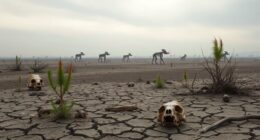If you’re looking for the best children’s books about conservation recommended by educators, I can help. From colorful titles like “The Bee Book” and “We Are Water Protectors” to engaging stories about sharks, weather, and ecosystems, there’s a wide range to inspire young minds. These books combine beautiful illustrations, simple science, and practical actions to foster environmental awareness. Keep exploring to discover more titles that make conservation fun and meaningful for kids.
Key Takeaways
- Many recommended books feature vibrant illustrations and engaging storytelling to teach children about ecosystems, animals, and environmental issues.
- Titles often incorporate cultural and indigenous perspectives to promote respect and global awareness of conservation efforts.
- Books like *We Are Water Protectors* and *The Bee Book* emphasize activism, community resilience, and practical conservation steps.
- Interactive features and tactile elements enhance engagement and help children understand complex ecological concepts.
- Resources are suitable for various age groups, from early readers to older children, fostering environmental awareness across developmental stages.
The Bee Book (Conservation for Kids)
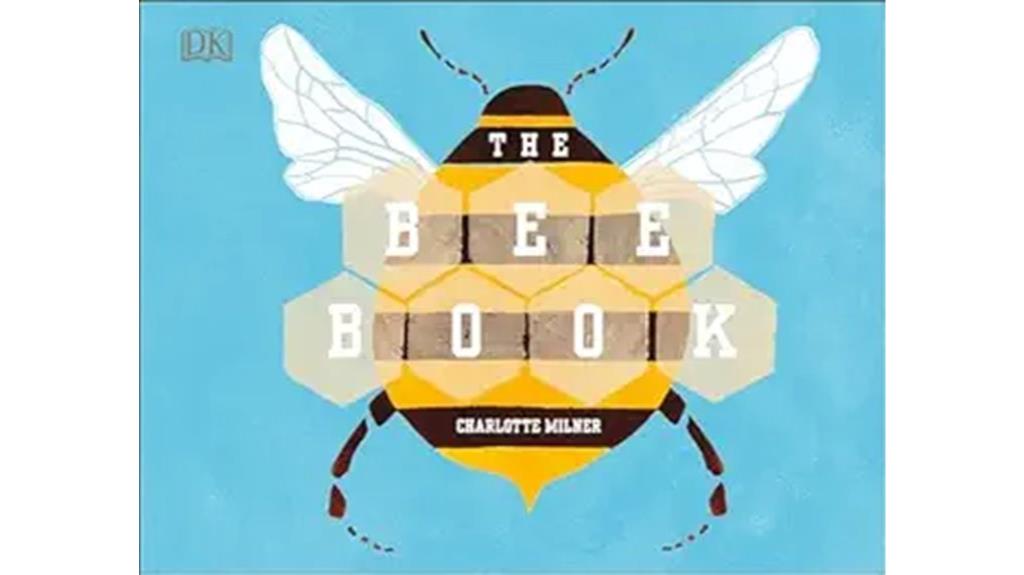
If you’re looking for a fun and educational way to introduce children aged 6-10 to the importance of protecting bees, “The Bee Book (Conservation for Kids)” is an excellent choice. I love how it explains bee biology, from the queen laying thousands of eggs to worker bees collecting nectar and pollinating plants. The colorful illustrations make learning engaging, and it clearly shows how bees build hives and produce honey. It also highlights the crucial role bees play in pollination and ecosystems. Most importantly, it encourages kids to understand the threats bees face and how they can help protect these incredible pollinators.
Best For: children aged 6-10, educators, and families interested in learning about bees and conservation in an engaging, educational way.
Pros:
- Bright, colorful illustrations that make learning fun and accessible
- Clear and straightforward explanations suitable for young learners
- Covers a wide range of topics from bee biology to conservation efforts
Cons:
- May be too simple for older or more advanced students seeking in-depth scientific details
- Limited focus on global bee conservation issues beyond basic awareness
- Some readers might prefer more interactive or hands-on activities included in the book
Because of an Acorn: Nature Autumn Books for Children
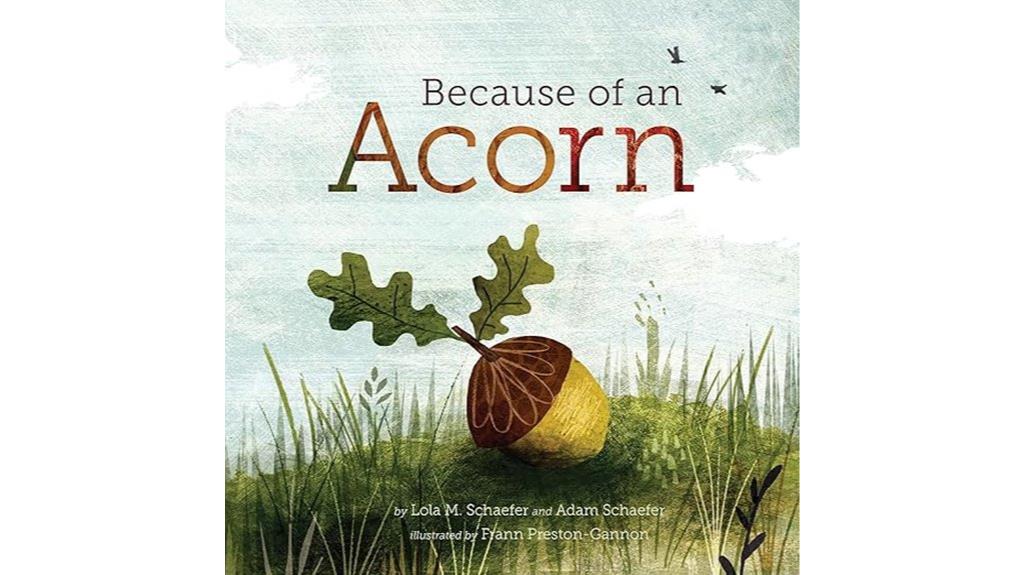
Because of an Acorn is an ideal choice for young children just beginning to explore nature’s wonders, thanks to its simple, poetic text that makes complex concepts like the food chain and natural cycles easy to understand. The book’s haiku-like language sparks curiosity and encourages discussion about cause and effect, interconnectedness, and the circle of life. With beautiful, true-to-life illustrations, it invites careful observation and makes learning engaging. Its minimal words are perfect for quick reads or in-depth conversations. Loved by kids, parents, and teachers alike, it fosters environmental awareness and a deeper appreciation for trees and ecosystems. It’s a wonderful tool for early nature education.
Best For: young children, parents, teachers, and caregivers seeking an engaging, educational book about nature, acorns, and ecosystems.
Pros:
- Uses simple, poetic language that makes complex natural concepts accessible to young learners.
- Features beautiful, realistic illustrations that enhance observation and understanding.
- Promotes environmental awareness and curiosity, encouraging discussions about ecosystems and conservation.
Cons:
- May be too brief for children wanting more detailed scientific information.
- Designed primarily for early readers; may not appeal to older children seeking in-depth content.
- Limited text might require additional explanation or context from adults for full comprehension.
We Are Water Protectors: (Caldecott Medal Winner)
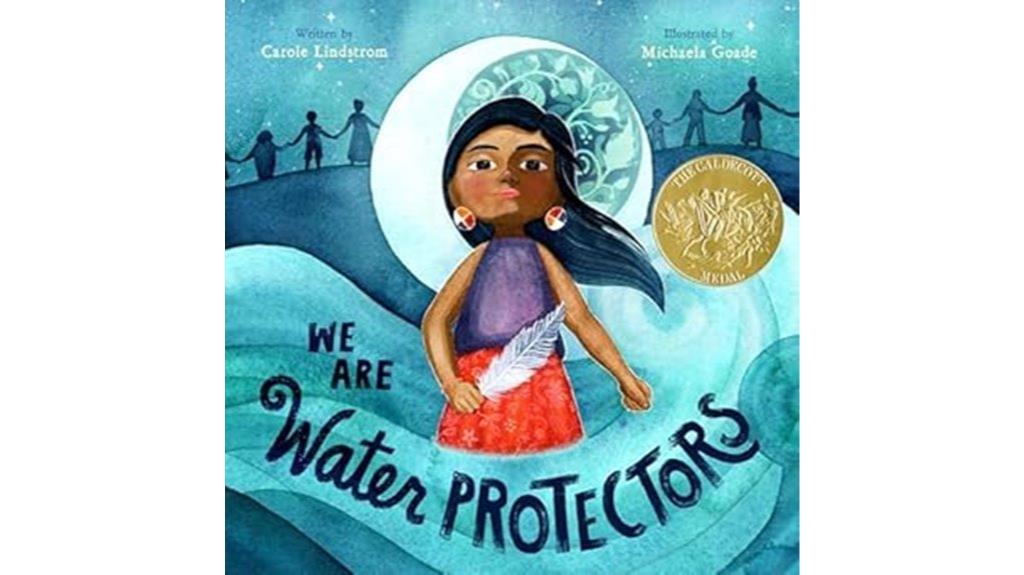
We Are Water Protectors stands out as an essential choice for educators and parents seeking to introduce children to environmental justice and indigenous culture through engaging storytelling. This Caldecott Medal-winning book highlights water’s crucial role and the importance of protecting natural resources. Through lyrical language and stunning illustrations inspired by Ojibwe beadwork, it celebrates indigenous traditions and community resilience. The story encourages awareness and action, fostering respect for land and water. Its powerful visuals and meaningful message make it a perfect tool for teaching environmental stewardship, cultural understanding, and hope—empowering children to become water protectors in their own communities.
Best For: educators, parents, and children interested in environmental justice, indigenous culture, and inspiring activism through beautiful storytelling.
Pros:
- Stunning illustrations inspired by Ojibwe beadwork that enhance cultural understanding and visual appeal.
- Engaging, lyrical storytelling that promotes awareness of water conservation and indigenous traditions.
- Serves as an effective educational tool for teaching environmental stewardship, diversity, and resilience.
Cons:
- Younger children may require additional explanation of the book’s hopeful ending and deeper themes.
- The poetic language might be challenging for early readers without guidance.
- Limited focus on specific indigenous tribes, which could require supplementary cultural context for complete understanding.
Hark! A Shark! All About Sharks (The Cat in the Hats Learning Library)

Are you looking for a charming, educational book that captures children’s attention while teaching them about marine life? I think you’ll love *Hark! A Shark! All About Sharks* from The Cat in the Hat’s Learning Library. It’s a colorful, durable hardcover that’s perfect for young readers. The book shares fun shark facts, from different species to their behaviors, all in lively Seuss rhymes that keep kids engaged. It’s ideal for children ages 3-5, especially shark enthusiasts. Many parents and educators praise its quality and educational value, making it a fantastic gift or addition to any children’s library. It’s both entertaining and informative, fostering curiosity about ocean creatures.
Best For: children aged 3-5 who love sharks, marine life, and engaging, educational storybooks.
Pros:
- Beautiful, durable hardcover design suitable for gifting and frequent handling
- Rhythmic Seuss-style rhymes that make learning about sharks fun and memorable
- Rich in factual information about shark species, behavior, and anatomy, enhancing educational value
Cons:
- The length of the book may be a bit long for very young or easily distracted children
- Some children might find the rhyming style a little repetitive after multiple readings
- As a specialized topic, it may appeal primarily to shark enthusiasts, limiting interest for some children
All About Weather Book
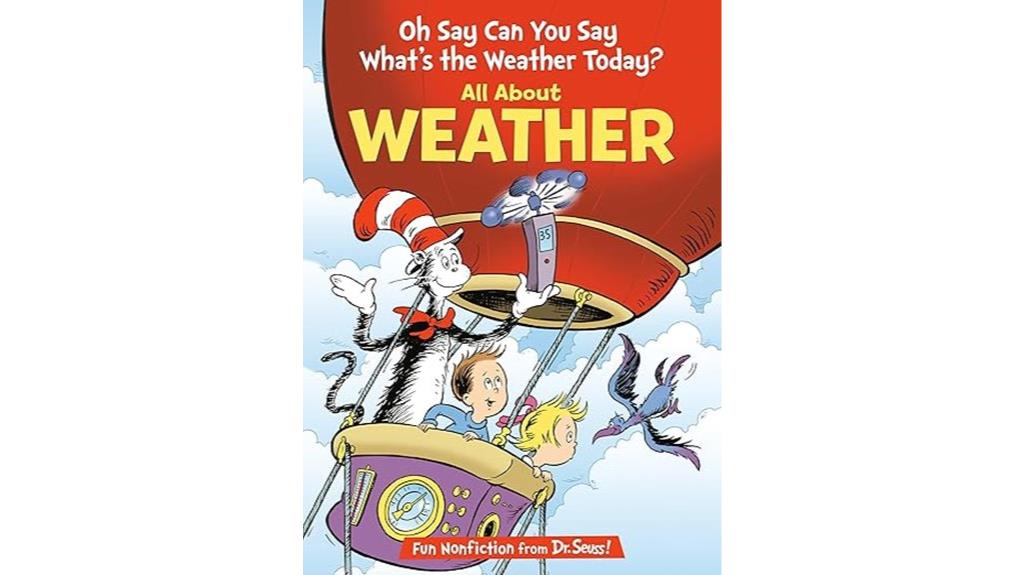
If you’re looking for an engaging way to introduce young children to the fascinating world of weather, the “All About Weather Book” from the CitH series is an excellent choice. Designed for kids aged 3-7, it combines bright pictures, playful rhymes, and simple explanations to make complex weather concepts accessible. Children will learn about different weather types worldwide and how weather works, sparking curiosity and understanding. Educators and parents praise it as both entertaining and educational, perfect for homeschooling, classroom activities, or as a thoughtful gift. This book truly makes learning about weather fun, helping children feel more confident and less fearful of storms.
Best For: young children aged 3-7, parents, educators, and anyone looking to introduce kids to weather concepts in a fun and engaging way.
Pros:
- Bright pictures and playful rhymes make learning enjoyable for young children.
- Simplifies complex weather topics, fostering curiosity and understanding.
- Versatile for homeschooling, classroom use, or as a thoughtful gift.
Cons:
- Some new copies may arrive with minor damage or imperfections.
- The rhyming style might not appeal to children who prefer straightforward text.
- Limited to weather topics, so not suitable for broader science education beyond weather and climate.
Wave: (Books about Ocean Waves, Beach Story Childrens Books)

For parents and educators seeking a peaceful yet inspiring read for young children, “Wave” stands out as an exceptional choice. This wordless book captures the beauty of ocean waves and beach adventures through stunning watercolor illustrations. It encourages children to use their imagination, creating stories about a girl interacting with a wave, fostering creativity and emotional connection. The artwork’s vibrant hues and simple yet powerful design evoke calm and wonder, making it perfect for inspiring storytelling and mindfulness. “Wave” not only entertains but also nurtures a child’s appreciation for nature’s beauty, inspiring a love for the ocean and environmental awareness.
Best For: parents, educators, and caregivers seeking a calming, inspiring, and beautifully illustrated wordless children’s book to foster creativity, emotional connection, and an appreciation for nature in young children.
Pros:
- Stunning watercolor artwork that captivates children and adults alike.
- Encourages imaginative storytelling and emotional development without words.
- Promotes mindfulness and a love for the ocean and nature through beautiful visuals.
Cons:
- Occasional printing flaws may affect the clarity of some illustrations.
- Its simplicity might be less engaging for older children seeking more complex stories.
- Some readers find the design and layout could be improved for better visual flow.
National Parks of the USA (Americana, 1)
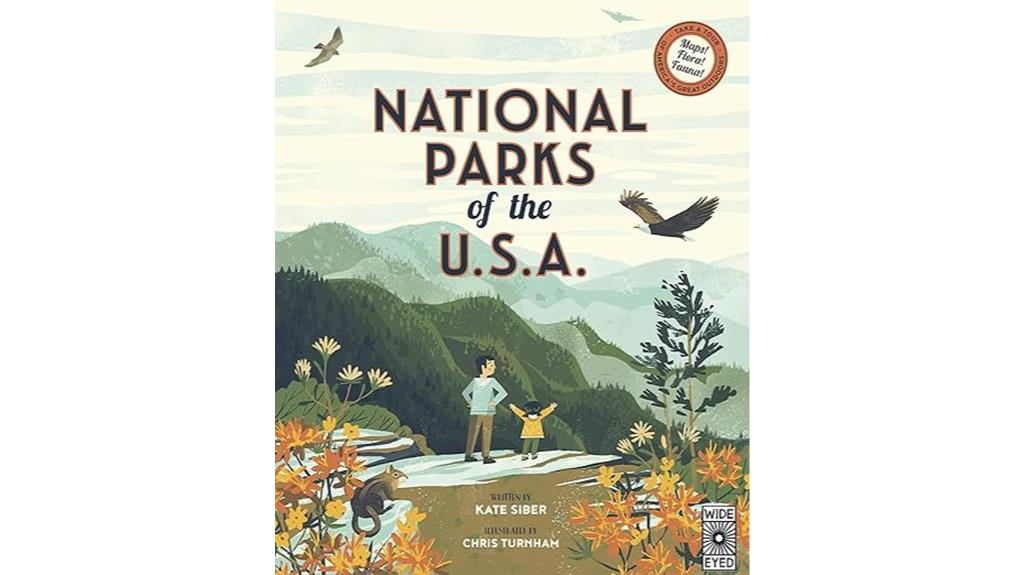
Children’s Books About Conservation, especially those highlighting the National Parks of the USA, are perfect for young readers enthusiastic to explore and learn about America’s natural treasures. I love how this book sparks excitement for parks like Yosemite and Acadia, inspiring family adventures and fostering a deep connection to nature. It’s packed with detailed facts about habitats, wildlife, and marine life, making it educational yet engaging. The stunning illustrations by Chris Turnham beautifully capture the parks’ beauty and diversity, making the book a visual delight. Although it covers only 21 parks, it offers a meaningful introduction that encourages children to appreciate and visit these incredible natural spaces.
Best For: families, teachers, and young readers eager to learn about and be inspired by America’s diverse national parks and natural beauty.
Pros:
- Beautiful, retro-inspired illustrations by Chris Turnham that enhance visual appeal and engagement.
- Well-organized, educational content suitable for children around 4th to 5th grade, with detailed facts on habitats and wildlife.
- Inspires a love of nature and future exploration, making it a meaningful gift and family keepsake.
Cons:
- Covers only 21 of the 63 national parks, which may feel limited for those seeking comprehensive coverage.
- Some may find the focus on certain parks less inclusive of all ecosystems across the country.
- The format is more suited for display or reading rather than a quick reference guide due to its detailed storytelling and illustrations.
I am Jane Goodall (Ordinary People Change the World)

I Am Jane Goodall is an excellent choice for young readers who are curious about inspiring female role models and the natural world. This engaging biography introduces children to Jane’s groundbreaking work with chimpanzees and her dedication to wildlife conservation. The book uses accessible language, authentic stories, and lively illustrations to make complex topics understandable. It encourages kids to pursue their passions, question societal norms, and care for the environment. Perfect for early readers, this book inspires curiosity about science, empathy for animals, and the power of perseverance. It’s a wonderful way to show children that they can make a difference in the world.
Best For: young children and early readers interested in inspiring female role models, science, and wildlife conservation.
Pros:
- Engaging and age-appropriate storytelling that inspires curiosity and empathy.
- Authentic content supported by lively illustrations and simple language.
- Promotes important values such as perseverance, environmental awareness, and questioning societal norms.
Cons:
- Might be too simplified for older or more advanced readers seeking in-depth information.
- Limited focus on other aspects of Jane Goodall’s life beyond her chimpanzee research.
- As a picture book, it may not satisfy those looking for comprehensive biographies or detailed scientific explanations.
Natures Best Hope (Young Readers Edition): How You Can Save the World in Your Own Yard
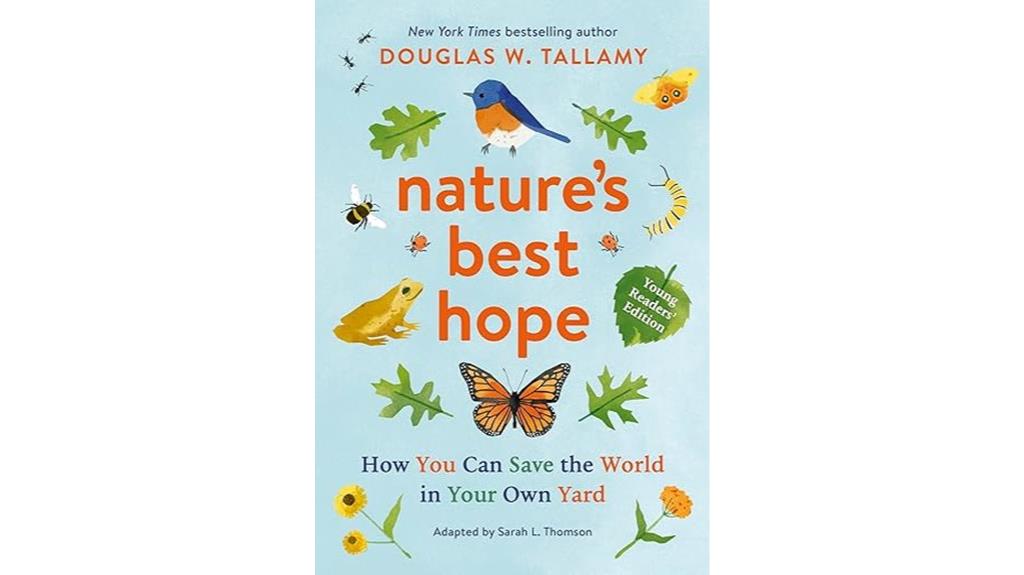
Natures Best Hope (Young Readers Edition): How You Can Save the World in Your Own Yard is an excellent choice for teens and adults enthusiastic to learn practical ways to protect the environment. It emphasizes that every creature depends on healthy ecosystems, and individuals can make a difference by planting native species, creating pollinator gardens, and fostering ecological awareness. While the book offers accessible, inspiring advice suitable for high schoolers and adults, some readers wish for more vibrant visuals, as the black-and-white images and low-quality paper can be disappointing. Despite this, its core message encourages proactive environmental action, making it a valuable resource for community and personal change.
Best For: Teenagers and adults interested in practical, accessible ways to protect and restore the environment in their own yards and communities.
Pros:
- Provides clear, engaging advice on planting native species and creating pollinator-friendly gardens.
- Suitable for high school students and older, making ecological concepts easy to understand.
- Inspires community projects and personal environmental responsibility through accessible messaging.
Cons:
- Features black-and-white images and low-quality paper that can be visually disappointing.
- Some content, like discussions on population control, may be controversial or better suited for adult audiences.
- Lacks vibrant visuals, which could enhance engagement, especially for younger readers or digital formats.
1,000 Facts About Sharks

If you’re looking for an engaging way to introduce young readers to the fascinating world of sharks, “1,000 Facts About Sharks” is an excellent choice. I love how this book combines high-quality content with stunning pictures that capture the imagination. It’s packed with fascinating facts that educate and entertain, making it perfect for curious kids interested in marine life. Many readers say it’s a favorite, inspiring young minds to learn more about sharks, their behavior, and their importance to ocean ecosystems. Whether as a gift or a classroom resource, this book is a fun, informative way to spark a lifelong interest in conservation and marine biology.
Best For: young readers, marine life enthusiasts, and gift buyers seeking an engaging, educational book about sharks.
Pros:
- High-quality content with fascinating facts and stunning pictures that captivate readers
- Excellent resource for inspiring curiosity about marine biology and conservation
- Suitable as a gift or classroom resource for children and shark lovers
Cons:
- May be too detailed for very young children who prefer simpler information
- Some readers might find the volume of facts overwhelming at first glance
- The focus on sharks might limit appeal for those interested in broader marine topics
The Book of Turtles

The Book of Turtles stands out as an ideal choice for young children who are curious about animals and enthusiastic to learn about nature’s fascinating creatures. I love how Sy Montgomery’s engaging writing and Matt Patterson’s detailed illustrations make turtle facts accessible and enthralling for kids aged 4-8. The book explores a wide range of turtle species, highlighting their remarkable adaptations, behaviors, and personalities. It also emphasizes their unique anatomy and intelligence, showing children how turtles communicate, hunt, and even solve mazes. Most importantly, it offers an inspiring message about protecting these incredible creatures and their habitats, making it both educational and motivational.
Best For: young children aged 4-8 who are curious about animals, nature, and want an engaging, educational introduction to turtles.
Pros:
- Colorful, detailed illustrations that capture children’s attention and enhance understanding.
- Combines accurate scientific information with accessible language suitable for young readers.
- Promotes conservation awareness and inspires children to protect wildlife and habitats.
Cons:
- May be too simple for older children or advanced readers seeking in-depth scientific detail.
- The focus on a broad range of species might limit depth on any individual turtle species.
- As a picture book, it may not satisfy those looking for comprehensive academic or technical content.
About Marsupials: A Guide for Children
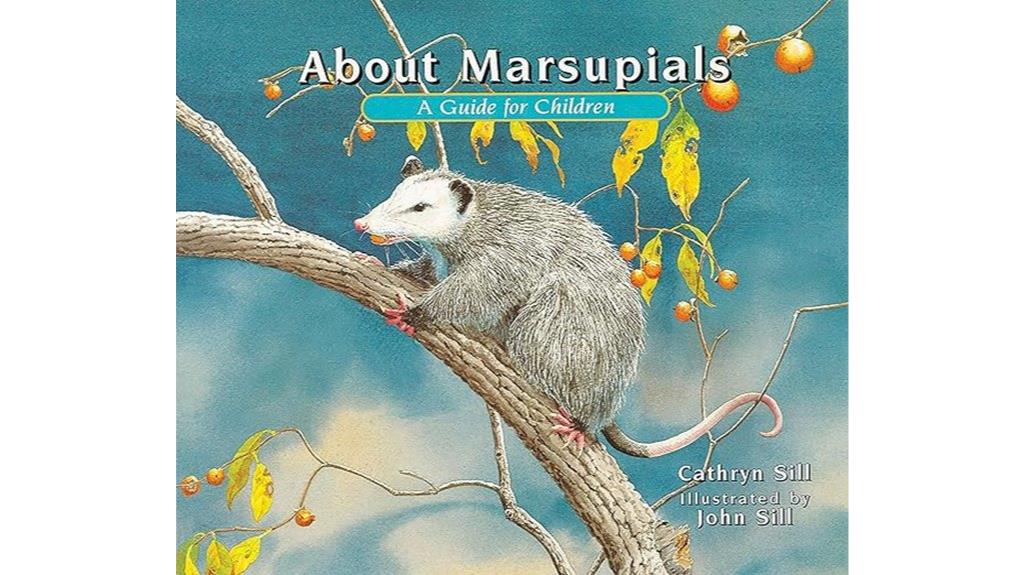
Are you curious about the amazing animals called marsupials and how they survive in the wild? “About Marsupials: A Guide for Children” is perfect for young readers aged 4 to 8 who want to learn fun facts about creatures like kangaroos, koalas, and opossums. This book uses simple language and engaging illustrations to explain their habitats, diets, behaviors, and unique features like pouch placement. It also highlights their geographic range, mostly in Australia, and discusses conservation challenges facing some species. It’s a great way for kids to explore the wild lives of these fascinating animals while understanding the importance of protecting their habitats.
Best For: curious children aged 4 to 8, parents, and teachers interested in learning about marsupials in an engaging and educational way.
Pros:
- Bright, life-like illustrations make learning appealing and captivating for young readers.
- Simple, clear language suitable for early elementary and emerging readers.
- Covers a wide range of topics including habitats, behaviors, adaptations, and conservation issues.
Cons:
- Some older children might seek more in-depth scientific details beyond the basics.
- The focus on Australian marsupials may limit exposure to less common species worldwide.
- The book’s concise format may not satisfy readers looking for extensive information or detailed science.
Bringing Back the Wolves: How a Predator Restored an Ecosystem
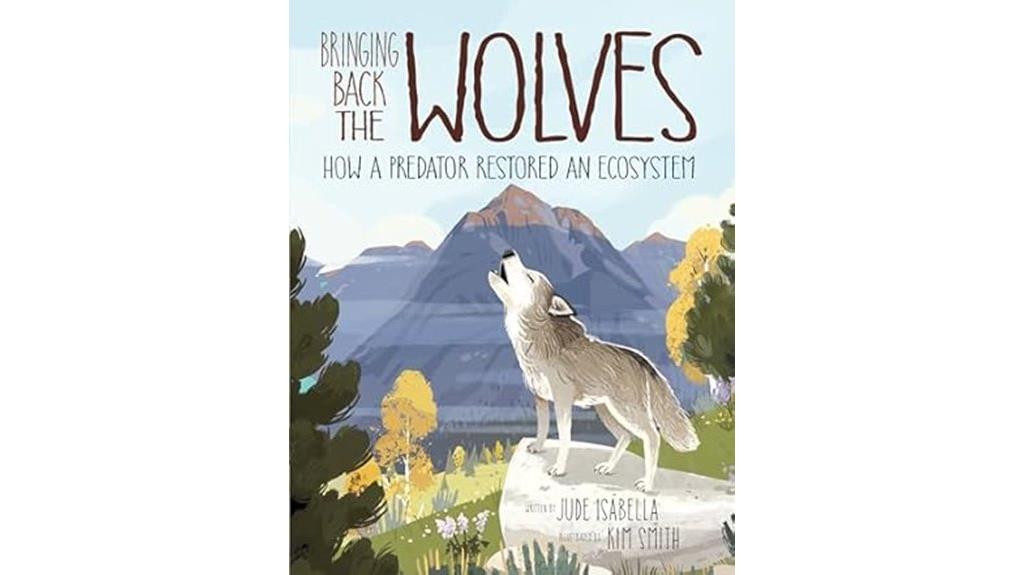
Children’s Books About Conservation like “Bringing Back the Wolves” are perfect for young readers who want to understand how animals influence their environment. I love how this book shows how reintroducing gray wolves to Yellowstone in 1995 reversed ecological damage caused by their absence. It explains simply how wolves controlled prey populations, which allowed plants to grow, streams to stabilize, and other animals to thrive. The illustrations and clear explanations make complex ideas accessible. This story highlights the importance of predators in maintaining healthy ecosystems and inspires kids to see conservation as a powerful way to protect nature’s balance.
Best For: young readers, educators, and conservation enthusiasts interested in learning about ecosystem balance and environmental restoration through engaging storytelling and vivid illustrations.
Pros:
- Simplifies complex ecological concepts making them accessible for children and beginners
- Beautiful illustrations and clear explanations enhance understanding and engagement
- Promotes awareness of conservation and the importance of predators in ecosystems
Cons:
- May be too simplified for advanced students seeking in-depth scientific detail
- Focuses primarily on Yellowstone, limiting broader ecological contexts
- Might require supplemental materials for comprehensive ecology or conservation education
Factors to Consider When Choosing Children’s Books About Conservation
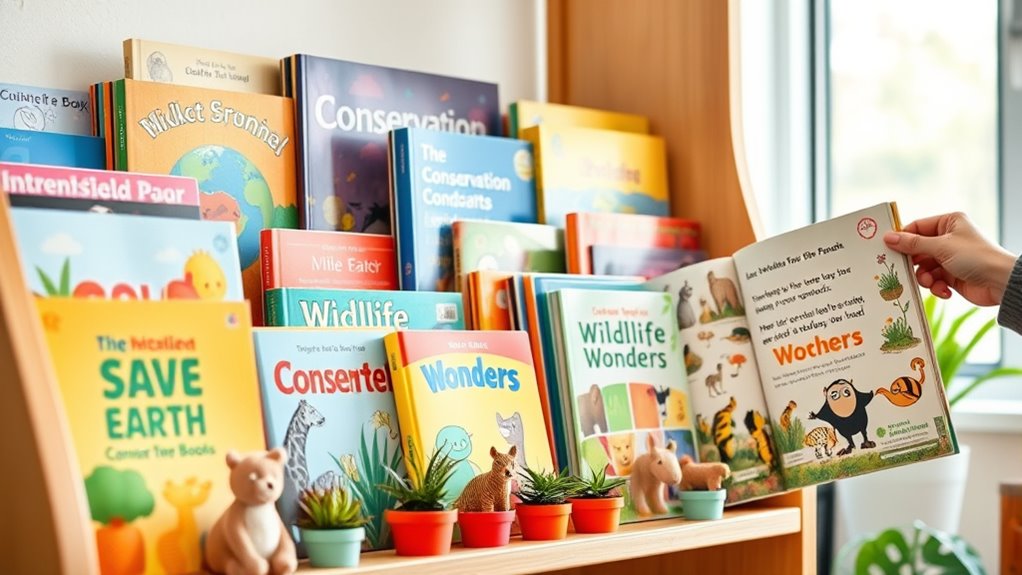
When selecting children’s books about conservation, I always think about whether the content is appropriate for the child’s age and understanding. I also look for engaging illustrations and accurate facts that inspire curiosity while conveying clear conservation messages. Additionally, I consider if the book reflects cultural relevance to ensure it resonates with diverse readers.
Age Appropriateness
Choosing the right conservation book for a child depends heavily on their age and developmental stage. For younger kids, look for books with simple language and clear concepts focused on nature and basic conservation. These stories should use bright, engaging illustrations and keep the length manageable to hold their attention. Older children can handle more detailed information about ecosystems, environmental challenges, and conservation efforts, so select books with richer content and more complex themes. It’s also important to guarantee the message aligns with their understanding, avoiding overly technical or abstract ideas that could confuse them. By matching the book’s depth and presentation to their age, you can foster a genuine interest in conservation without overwhelming or boring them.
Engaging Illustrations
Engaging illustrations are a powerful tool for capturing a child’s interest and making conservation topics come alive. Colorful, detailed, and visually appealing images draw kids in and spark their curiosity about the environment. High-quality artwork helps convey complex concepts through visual storytelling, making abstract ideas easier to understand. Including natural scenes, animals, and ecosystems can evoke emotional connections and foster empathy for wildlife and habitats. The style of illustrations, whether realistic or whimsical, should match the book’s tone to boost engagement and support the story effectively. Clear, vibrant images with minimal clutter allow children to focus on key conservation messages. Ultimately, engaging illustrations make learning about conservation exciting and memorable, encouraging kids to care about the planet.
Accurate Facts
Selecting children’s books about conservation requires guaranteeing that the information they contain is accurate and trustworthy. I look for books backed by reputable sources or experts, so the facts about ecosystems, species, and environmental issues are correct. It’s essential that the book clearly distinguishes between verified facts and opinions or guesses, helping kids develop critical thinking skills. Well-researched books include current data, such as species population numbers, habitat ranges, or ecological roles, supporting their accuracy. I avoid books with myths or outdated information that could mislead young readers. Accurate facts lay a solid foundation for understanding conservation, making it more meaningful and impactful. When choosing a book, verifying the credibility of the information ensures children learn the truth about our environment.
Clear Conservation Messages
How can you tell if a children’s book effectively delivers a conservation message? First, look for clear, simple language that explains why protecting nature matters. The message should focus on specific issues like habitat loss or pollution, making the problem understandable without being overwhelming. Check if the story encourages kids to take action, like recycling or planting trees, so they feel empowered to make a difference. Engaging visuals and illustrations are essential—they make abstract ideas concrete and memorable. A strong conservation message also sparks curiosity and ongoing interest in caring for the environment. When these elements come together, the book not only educates but inspires young readers to become environmental stewards in their everyday lives.
Cultural Relevance
Considering cultural relevance is essential when choosing children’s books about conservation because it helps young readers see themselves and their communities reflected in the story. Selecting books that showcase diverse cultures and indigenous perspectives promotes inclusivity and fosters understanding. It’s important to guarantee the story accurately represents cultural practices and beliefs related to nature, which builds respect and authenticity. Incorporating cultural symbols, art, or traditions can connect conservation themes with children’s backgrounds, making the message more meaningful. Additionally, highlighting the roles of different communities worldwide emphasizes our global interconnectedness. Prioritizing titles that respectfully portray indigenous and local voices helps children appreciate varied cultural approaches to conservation and develop a broader, more inclusive view of environmental stewardship.
Interactive Elements
Interactive elements like flaps, tabs, and textured materials can make children’s books about conservation much more engaging and memorable. These features invite kids to touch, explore, and discover, making complex ecological concepts easier to grasp. Books with prompts or questions encourage critical thinking, helping children develop their own ideas about protecting the environment. Incorporating fold-out diagrams or pop-ups can visually clarify intricate ecological processes, enhancing understanding. Interactive features also motivate children to connect stories to real-world actions, fostering a sense of agency. Plus, well-designed interactive components often lead to repeated reading, reinforcing conservation messages over time. Overall, these elements transform learning into an active experience, making conservation topics exciting and meaningful for young readers.
Readability Level
Choosing the right children’s book about conservation starts with paying attention to its readability level. It’s important that the language matches the child’s age or reading ability, usually around grades 1-4 for younger kids. Look for books that use simple words, short sentences, and familiar vocabulary to help children understand and stay engaged. Visual aids like illustrations or photos are also essential—they support learning without overwhelming the text. A good book balances scientific accuracy with accessible storytelling, making complex conservation ideas understandable and interesting. Ensure the language isn’t too challenging for independent reading or guided sessions, so children feel confident and motivated to learn. Selecting books with the right readability level makes the conservation message both clear and enjoyable.
Environmental Impact
Have you ever wondered how the stories in children’s books about conservation show the impact of human actions on the environment? These books should highlight issues like pollution, deforestation, and habitat destruction to help kids understand their ecological footprint. Effective titles emphasize sustainable practices, such as recycling, reducing waste, and conserving water, encouraging responsible behavior. Including factual details about consequences like species decline or ecosystem imbalance helps children grasp the real effects of neglect. Stories that showcase how individual or collective actions—like planting native species or protecting wildlife—can make a difference inspire hope and action. Engaging visuals paired with clear messages about environmental impact motivate children to develop lifelong habits of stewardship, making these books powerful tools for raising environmentally conscious future advocates.
Frequently Asked Questions
How Do These Books Effectively Teach Conservation to Young Children?
These books effectively teach conservation to young children by engaging them with colorful illustrations and simple, relatable stories. I find they spark curiosity and empathy, making complex environmental concepts easy to understand. Through characters and adventures, children learn about protecting nature, recycling, and caring for animals. I believe that combining storytelling with vivid visuals helps young readers grasp the importance of conservation in an enjoyable, memorable way.
Are These Books Suitable for All Age Groups Within Children?
Yes, these books are suitable for various age groups within children. I find that simpler stories with vivid illustrations work well for younger kids, helping them grasp basic conservation concepts. For older children, I recommend books with more detailed information and engaging narratives to deepen their understanding. I believe choosing age-appropriate books guarantees children stay interested and learn effectively, fostering a lifelong appreciation for conservation.
Do These Books Include Activities or Suggestions for Conservation Actions?
Yes, many of these books include activities or suggestions for conservation actions. I find that they often feature engaging prompts, simple projects, or practical tips that kids can try at home or school. These ideas help children connect with the concepts, encouraging them to make a positive impact in their communities. I love how interactive and empowering these books are, making conservation fun and accessible for young readers.
How Do These Books Depict Diverse Ecosystems and Species?
I find that these books beautifully showcase diverse ecosystems and species by highlighting their unique features and interconnections. I love how they often include vibrant illustrations and engaging stories that introduce children to rainforests, oceans, deserts, and wetlands. These books emphasize the importance of each environment and its inhabitants, inspiring kids to appreciate biodiversity and understand our role in protecting these essential ecosystems.
Can These Books Be Used in Classroom Conservation Education Programs?
Absolutely, these books are a game-changer for classroom conservation programs! They inspire young minds, sparking a passion for protecting our planet. I’ve seen students become mini environmentalists after reading them, enthusiastic to learn more and take action. Their engaging stories and vivid illustrations make complex ideas accessible. Using these books in lessons can truly transform how kids see their role in conserving ecosystems and species.
Conclusion
Choosing the right kids’ books about conservation is like planting seeds for the future—each story a tiny act of hope. While some books explore into the wild, others explore the skies or oceans, reminding us how diverse and interconnected our world is. Just like children learning about sharks or turtles, we can all grow more curious and caring. After all, nurturing young minds today helps protect the planet tomorrow.






